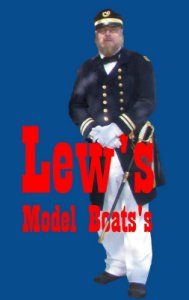
|
Welcome to - Lew's Model Boats - and more! |
go to Home Page |
| LewsModelBoats.org is not a commercial web site. Lew is a scale model builder/hobbiest (model boats and more). Views on this web site are opinions of the author and not driven by any commercial entity. Opinions are welcome - by mailing Lew (see contacts). © Copyright 2024 Lew's Model Boats. Disclosure: This Lews Model Boats do not have any financial ties to any company, political affiliation nor any other subsidy and has no gains from these and any other person(s). Lews Model Boats and this site is purely for the enjoyment of its viewers and others who enjoy this hobby. |
Section 2 - Photos & Data
First, let's start with the data. We can eliminate some of the names of the twenty ferry-gunboats several ways. First (and most important) is to eliminate all naves of those not in the North Atlantic Blockading Squadron and Potomac/James River Squadrons as those were likely not to have been photographed in the remote areas. We could eliminate more names because they were never identified by name with any of the photos (but let's not for now). We can eliminate several which did not fit the photos below because of size and/or layout. We will end up with the following that all served in the areas indicated with the photographs:
Owner ..........................................USN Name.........................Purch $$..Service Built..............................Disp – Hull - Pwr.....LWL X B X DH.........Arms & Builder
Williamsburg Ferries......................Commodore Perry.............$38,000....NABS .....1859 (Brooklyn) ....... 512 – W – S – P.....143 X 33 X 12 ....... 2-9” S.B., 2-32# S.B.,..Stack & Joyce
Williamsburg Ferries......................Commodore Barney ..........$38,000....NABS......1859 (Brooklyn) ....... 512 – W – S - P .....143 33 12 ............. 1-100# Rifle, 3-9” S.B. Perrine, Patterson
Union Ferry Co. ...........................Commodore Jones............$83,000....NABS .....1863? (?) ................. 542 – W – S – P.....154 X 32 X 11 .........1-9” S.B., 1-5.1” Rifle, 2-24# Howit.
Union Ferry Co. ...........................Commodore Morris ...........$42,409....NABS .....1862 (New York) ..... 532 – W – S – P.....154 X 32-1/2 X 12 ....1-9” S.B., 1-100# Rifle, 4-24# Howit.
Union Ferry Co #22095 ...............Commodore Read.............$91,000....Potomac..1857 (Brooklyn) ....... 650 – W – S – P.....179 X 33-1/2 X 13 ....2-100# Rifle, 4-24# Howit.
Staten Island & New York Ferry ...Hunchback .......................$45,000....NABS .....1852 (New York) ..... 578 – W – S – P.....179 X 29 X 10 ......... ('63) 4-9"SB; 1-200Pd;1-12Pd Rifle... S.B. Simonson
Now for some real confusion!
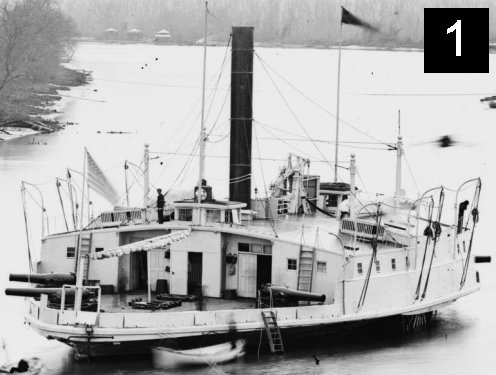
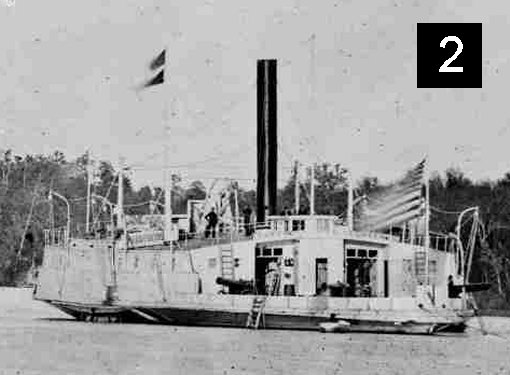
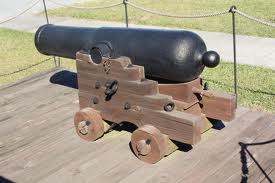
So, what is the name of the ferry-gunboat in these photos? It is most likely not the Hunchback. The known close-yp photos (below) of the Hunchback don't match the two above. It is also likely this is not the Commodore Perry (see information below next to photo 5). If not the Perry, then probably not the Barney as it was built the same year as the Perry and for the same ferry line. This boat has three guns on end "A" and one visual on end "B." Usually, the guns were distributed somewhat evenly on both ends. The Perry (drawing "4" shows two + two) and Barney each had four guns. Photo "3" seems to have five (three + two). Commodore Read, and Commodore Morris, each had six guns. If these boats had six guns (versus four for the others), then three on each end would seem likely, like the photos here.
These photos not appear to be like the 24-pounder howitzer (photo, left). Both guns near the superstructure look to be the same. I hate to take a guess, but from what I see here this evidence seems to lean toward the boats in the photos 1, 2 & 3 being named the Commodore Morris. Another possibility is the Commodore Read, which was 25-feet longer and 118 tons heavier than the Morris. Confusion is understandable when you realize (as indicated in the ORN reports) that the Commodore Perry, Commodore Morris, Commodore Barney, Commodore Hull, and Hunchback all operated in the same waters and on occasions, together. More research is needed here.
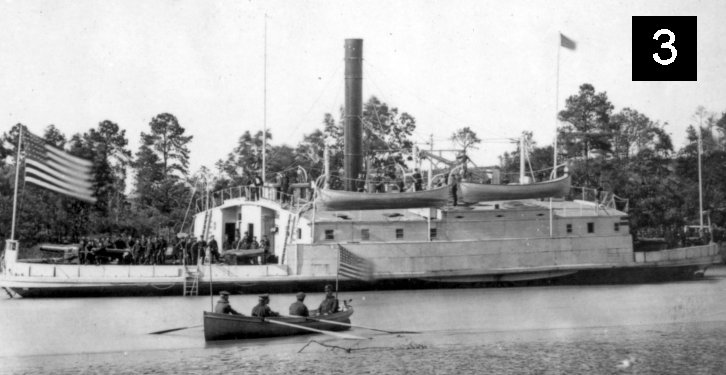 The
"Warships in the Civil War" (Paul Silverstone, Navy Institute Press,
1989) list's the photo at the right photo as the
Commodore
Morris. The National Archives list's this at the
Commodore Barney, and was photographed by Mathew Brady. Many web sites list
this as the
Commodore Perry and others the Hunchback.
More confusion!
The
"Warships in the Civil War" (Paul Silverstone, Navy Institute Press,
1989) list's the photo at the right photo as the
Commodore
Morris. The National Archives list's this at the
Commodore Barney, and was photographed by Mathew Brady. Many web sites list
this as the
Commodore Perry and others the Hunchback.
More confusion!Now we need to look at which end is the bow and which is the stern. Sure, they are double ended and can go in either direction. However, I believe that for consistent operations they did have a forward and aft. So, I ask... Which end is the bow?
First, I will identify one end as "A" (end closes to the stack) and the other as "B" (end closest to the walking beam).
Tradition is that the ensign (national flag)is flown on the stern or other prominent place. However, check out the anchor in the photo "1" below the ensign mast. (Is "A" the stern or bow?) Also look at the photo "5." The torpedo catching boom is protruding to the right, or end "B." Photo "3" has the transoms (back) of the ships launches on the davits facing to the left, end "A." To confuse matters even more, photo "6" has the launch on the left with the transom facing the camera and the one on the right with the bow facing the same direction.
To further confuse this issue, the National Archives identifies photo 3 as "Commodore Barney, stern quarter, on the James River." (What evidence they used other than the ensign being flown on the stern is not indicated.)
None of the boats were photographed while moving, so the position the flags are flying in is most likely caused by the wind. Also, did these boats have a single rudder or two rudders? A note in the ORN about the USS Hunchback needing repairs, it is stated that "One of here rudders are gone."
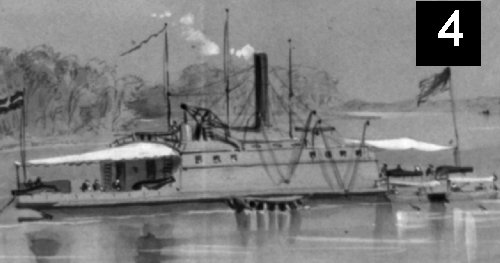 Normally, I do not rely on sketches and drawings. However,
this one is from the Library of Congress. The artist/author
specifies in the text description (on the same sheet of paper) that
this is the Commodore Perry
on the James River:
Normally, I do not rely on sketches and drawings. However,
this one is from the Library of Congress. The artist/author
specifies in the text description (on the same sheet of paper) that
this is the Commodore Perry
on the James River:View on the Appatomox at Port Walthall. The nearest point to Petersburg, approached by the Gun Boats the one shown in the sketch is the Commodore Perry commanded by Captain Amos P. Foster.
Formerly attributed to Alfred R. Waud, with the call number DRWG/US - Waud, no. 554 (A size). Published in: Harper's Weekly, July 23 1864, p. 468, attributed to William Waud.
In looking at this drawing, we see a lot of detail in common with photo 5 (below) as well as similarities to the photos above. This includes a squat, rectangular pilot houses, number of windows (ports) on the side, raised area over the side-wheels (including three small ports), and vertical armor plates on the end decks. To me, 4 and 5 are a match and indicates that these are the Commodore Perry (in conflict with photo 6 below) as they are from two independent sources.
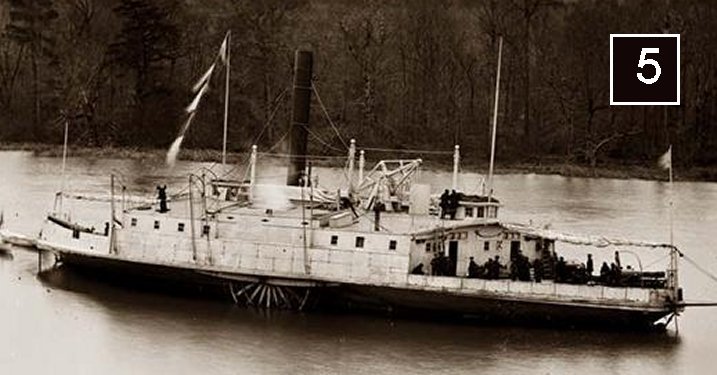
This photo taken on the James River has been identified as the USS Commodore Perry. This was printed on the edge of the photo mount and looks like this was done at the time the photograph was printed. This is from the original photo up for auction by Cowan, identified as "Gunboat Com. Perry, on the James River; a torpedo on the bow of the boat, No.2684."
Now compare this to the three photos above. Are they all the same? There are a lot of similarities but no the same. (The ferry at the left sits higher in the water, but that could be for a variety of reasons.) One noticeable difference is the for and aft decks.
The top photos (1, 2, 3) seem to have elliptical decks as viewed from overhead. The photo at the left seems to have a longer, tapered, blunted end. The photos at the top show the "A" end of the superstructure, and the photo at the left is looking at the "B" end. Even though we are looking at the opposite ends, there is a small door between the two larger recesses in the top photo that is not in photo 5.
It is only a assumption here, but I would think the door would be on both ends, probably from the ferry days before the war, and would lead up to the pilot house on each end. If these (deck ends and small door) are true, then photo 5 does not match 1, 2, & 3. The Perry was built in 1859 by Stack & Joyce and the Barney in 1859 by Perrine, Patterson. Both the Commodore Barney and Commodore Perry were built for Williamsburg Ferries and have the same dimensions and displacement.
There is a difference in the heavy guns mounted. The Commodore Perry had two 9-inch smoothbores, and two 3-pounder smoothbores. The Commodore Barney had one 100-pounder rifle and three 9-inch smoothbores.
Now lets
look at the known USS Hunchback
photos of the "A" end. Notice the stack appears closer to this
end, however there is only a single ladder to the upper deck and
that is closer to the pilot house. This confirms that the
three photos at the top are not of the
Hunchback.
Strangely enough, the Mathew Brady collection label's the lower left
photo as the Agawam,
which it could not be unless someone removed the big mast where the
officers are sitting.
The style of this ferry-gunboat is quite different from the three top photos.
The Pilot houses are round, the whole center of the superstructure
is recessed, there are no raised overhead deck/roof over the side wheels, and
the end appears to have a squared-off snout rather than an
elliptical deck. The center gun appears
to be a 5.1-inch or a 100-pounder rifle and the gun facing left looks
like a 9-inch smoothbore. Also note that the
walking beam is not visible here. They are quite tall
(9-11 feet) and should be visible. It should be between
the stack and the far pilot house. The
Commodore Morris's engine was
inclined so there would be no walking beam above the upper
decking. The fold up armor
plates are several feet in from the gunwales, giving the appearance of a smaller deck.
Clues in this photo:
Look close at the deck you see two smooth bore guns and the third gun behind the three men at
the right is a howitzer pm a boat carriage. The
Perry, Barney, and
Hunchback did not have this type gun. Here is
the armament for these three boats:
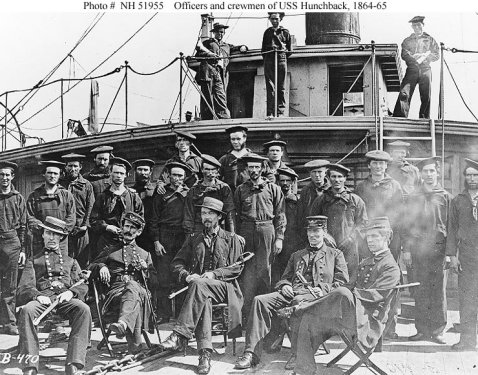
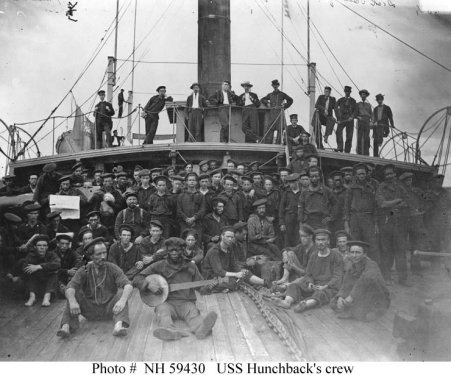
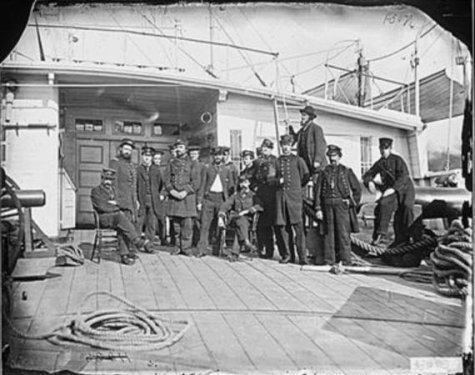 Next, lets look at the photo (left) identified by the National Archives as the
Commodore Barney. Although somewhat similar to the three top photos (1, 2, 3), it
is not identical. The skylights above the doors are different
as well as the windows (ports?) behind the men. This also does
not appear to be the Hunchback
as well.
Next, lets look at the photo (left) identified by the National Archives as the
Commodore Barney. Although somewhat similar to the three top photos (1, 2, 3), it
is not identical. The skylights above the doors are different
as well as the windows (ports?) behind the men. This also does
not appear to be the Hunchback
as well.
After the war (1866), the
Hunchback was sold to commercial
interests in Boston and named the General Grant.
It was abandoned in 1880. The East Boston Ferry Company listed
General Grant
as one of the its steam five steam ferries.
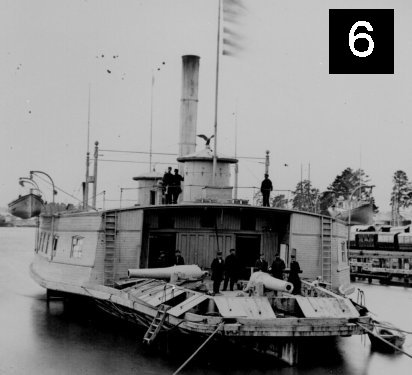 This photo is commonly identified as the USS
Commodore Perry
and labeled part of the "Matthew Brady collection."
However, the Brady collection (and this is one of three know photos
taken at this spot, only indicates this as a gunboat on the Pamunkey
River. The Civil War Sailors Museum has identified this as the USS
Commodore Barney. However, "Warships in the Civil
War" (Paul Silverstone, Navy Institute Press, 1989) list's this
photo as the Commodore Morris.
This photo is commonly identified as the USS
Commodore Perry
and labeled part of the "Matthew Brady collection."
However, the Brady collection (and this is one of three know photos
taken at this spot, only indicates this as a gunboat on the Pamunkey
River. The Civil War Sailors Museum has identified this as the USS
Commodore Barney. However, "Warships in the Civil
War" (Paul Silverstone, Navy Institute Press, 1989) list's this
photo as the Commodore Morris.
The National Archives list's this photo as identifier
524831 and "Commodore Perry" - "Series:Mathew
Brady Photographs of Civil War-Era Personalities and Scenes,
compiled 1921 - 1940, documenting the period 1860 - 1865."
Commodore Jones: One 9” Smooth Bore; one 5.1” Rifle, two
24-pounder Howitzers
Commodore Read: Two 100-pounder Rifles; four 24-pouunder Howitzers
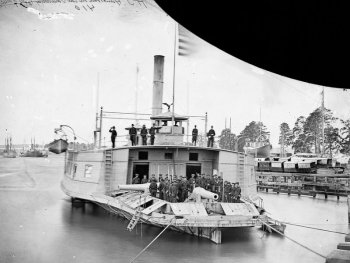
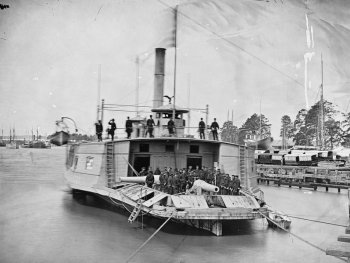
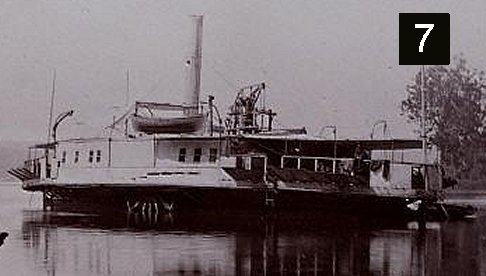
This could very well be the
Commodore Barney as Frank
Leslies Illustrated (newspaper) stated that in June 1864,
the USS Commodore Barney was rocked by a torpedo explosion
on the James River, and lost her pilot house.
Notes:
The Commodore Barney, Commodore
Perry, and Morse were
considered "sister ships." They all had 500HP vertical
walking beam engines built by Novelty (NY). The
Barney
and
Perry
were built by Stack & Joyce and the
Morse
by Roosevelt.
The USS
Commodore Barney
(ex-Ethan Allen)
was returned to the Williamsburg Ferry Company in 1865 and
"repaired" (brought back to ferry service) having their
boilers rebuilt that year.
The Commodore Barney
(Ethan Allen
before the war) was sold to Florida interests in 1885 and
wrecked in 1901.
The USS Commodore Perry (ex-Commodore
Perry)
was returned to the Williamsburg Ferry Company on July
12, 1865 and "repaired" (brought back to ferry service)
having their boilers rebuilt that year. The Commodore Perry
was sold to Charleston interests in 1896 and abandoned in 1907.
The Morse was
returned to the Williamsburg Ferry Company on July 20, 1865
and "repaired" (brought back to ferry service) having their
boilers rebuilt that year.
The Commodore Morris
was sold back the the Union Ferry Company on July 15, 1865
and completely rebuilt.